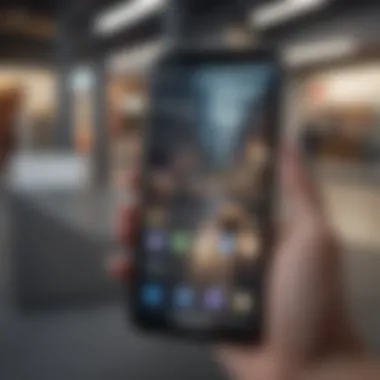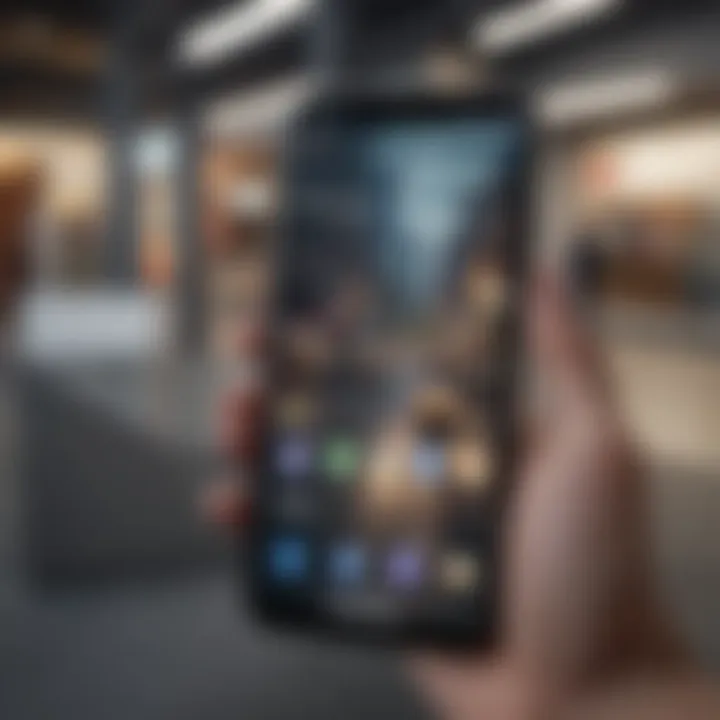A Comprehensive Comparison: Samsung Phone vs. iPhone - Unveiling the Best Choice


Product Overview
When delving into the realm of high-end smartphones, it is inevitable to encounter the perpetual battle between two tech giants: Samsung and Apple. Samsung, with its innovative design ethos and feature-rich devices, stands as a formidable competitor to Apple's sleek and sophisticated i Phones. Each brand boasts a unique identity, reflected in their design language, user experience, and overall performance.
Samsung Phones
With a focus on versatility and cutting-edge technology, Samsung phones are renowned for their vibrant displays, sleek aesthetics, and robust build quality. From the flagship Galaxy S series to the innovative Galaxy Fold, Samsung offers a diverse range of devices to cater to varying consumer preferences and demands.
iPhones
In contrast, i Phones by Apple embody a minimalist and elegant design philosophy. With a seamless integration of hardware and software, iPhones deliver a premium user experience characterized by smooth performance, intuitive navigation, and a cohesive ecosystem of apps and services. Apple's attention to detail and craftsmanship sets the bar high in the realm of smartphone design.
Performance and User Experience
Performance serves as a cornerstone in evaluating the worth of a smartphone. Samsung phones, equipped with powerful processors and ample memory, excel in multitasking and demanding applications. The One UI interface ensures a smooth and intuitive user experience, offering a plethora of customization options and productivity features.
On the other hand, i Phones showcase optimization at its finest. The marriage of Apple's hardware and iOS results in an ecosystem that prioritizes fluidity and efficiency. Whether it's the seamless integration of apps, the buttery-smooth performance, or the security features embedded within the system, iPhones aim to deliver a premium user experience unmatched by many.
Comparison with Previous Models or Competitors
Over the years, both Samsung and Apple have continuously raised the bar in terms of innovation and technological advancements. Samsung's iterative approach refines the user experience with each new iteration, focusing on enhancing key features and addressing consumer feedback. The Galaxy series competes with itself, each model pushing the boundaries of what a smartphone can achieve.
Conversely, Apple's incremental updates aim at refining the user experience rather than reinventing the wheel. With each new i Phone release, Apple enhances performance, camera capabilities, and overall user satisfaction. The competitive landscape in the smartphone industry continuously evolves, driving both brands to outdo themselves and set new standards.
Tips and Tricks
To extract the maximum potential from an i Phone, mastering its nuances and hidden features is imperative. From optimizing battery usage and configuring privacy settings to discovering shortcuts and enhancing productivity, delving into the tips and tricks corner of iPhones can significantly enhance user experience. Troubleshooting common issues and exploring lesser-known functionalities can elevate the overall satisfaction derived from using an iPhone.
Latest Updates and News


The tech landscape is ever-evolving, with constant updates and innovations shaping the future of smartphones. For Apple enthusiasts, staying informed about the latest software updates, feature releases, and industry rumors is crucial. Industry events and announcements provide a glimpse into the next big thing from Apple, building anticipation and excitement among tech aficionados.
Introduction
In the realm of smartphones, the perpetual debate between Samsung and Apple's i Phone remains a focal point for tech enthusiasts, industry professionals, and Apple aficionados alike. The rivalry between these two tech giants transcends mere comparison; it symbolizes a clash of design philosophies, user experiences, and brand loyalties. This article undertakes the ambitious task of dissecting and juxtaposing Samsung phones against iPhones, delving into intricate details across various crucial facets to aid readers in deciphering the nuances that delineate these flagship devices.
As we embark on this comparative odyssey, it is imperative to grasp the foundational importance of this exploration. Not merely a juxtaposition of hardware and software, this analysis encapsulates the core essence of contemporary technological innovation and consumer preferences. The determination of whether to opt for a Samsung phone or an i Phone extends beyond mere utility; it embodies a social statement, a reflection of personal taste, and a testament to individual priorities. By comprehensively dissecting the design, performance, camera capabilities, software ecosystems, pricing models, and long-term value propositions of Samsung phones and iPhones, readers will be equipped with invaluable insights enabling them to navigate the labyrinthine landscape of flagship smartphones with clarity and discernment.
Design and Build Quality
In the realm of premium smartphones, design and build quality play a pivotal role in shaping consumer preferences. The aesthetics and construction of a device not only contribute to its overall visual appeal but also impact its durability and user experience significantly. Samsung and Apple, as frontrunners in the smartphone market, have distinct approaches to design that cater to different tastes and preferences.
Material Choices
Material choices are a critical aspect of design and build quality for smartphones. Samsung predominantly uses materials like glass and metal in its flagship devices, offering a sleek and premium feel. On the other hand, Apple is known for its emphasis on aluminum and glass, creating a sophisticated and minimalist aesthetic. The choice of materials not only affects the device's appearance but also its weight, sturdiness, and susceptibility to damage.
Ergonomics and Comfort
Ergonomics and comfort are essential considerations in the design of smartphones to ensure a pleasant user experience. Samsung devices are often praised for their larger screens and curved edges, providing a comfortable grip and immersive viewing experience. In comparison, Apple focuses on compact designs that are easy to hold and operate with one hand, catering to users seeking practicality and ease of use. The ergonomic differences between Samsung phones and i Phones influence how users interact with their devices on a daily basis.
Durability
Durability is a key factor in assessing the overall quality of a smartphone. Samsung and Apple employ different approaches to enhance the durability of their devices. Samsung devices often feature reinforced glass and metal frames to withstand impact and everyday wear and tear. Apple, on the other hand, prioritizes rigorous testing and quality control to ensure its devices are resilient. The durability of a smartphone is a significant consideration for consumers looking for a long-lasting investment that can withstand the rigors of daily use.
Performance and Hardware
In the realm of smartphones, the Performance and Hardware segment stands as a pivotal factor that discerns the capability and efficiency of devices; this segment plays an integral role in delineating the differentiation between Samsung phones and i Phones. Understanding the intricacies of Performance and Hardware is paramount for tech enthusiasts and potential buyers alike. By scrutinizing the core components that power these devices, such as processors, RAM, graphics capabilities, and battery life, individuals can make insightful decisions based on their usage patterns and preferences.
Processor and RAM
When delving into the Processor and RAM aspects of Samsung phones versus i Phones, it becomes evident that the efficiency and multitasking prowess of a device are heavily influenced by these components. The processor acts as the brain of the smartphone, dictating its speed and the smoothness of operations. In parallel, the RAM determines the device's ability to handle multiple tasks simultaneously without lag. Samsung phones are renowned for their employment of cutting-edge processors and generous RAM configurations, catering to users who demand seamless performance for gaming, multitasking, and resource-intensive applications. On the contrary, iPhones are lauded for the optimization between hardware and software, ensuring that even with seemingly lower RAM capacities, the devices deliver impeccable performance. The comparison between Samsung's powerhouse processors and RAM offerings with Apple's integrated efficiency showcases a nuanced juxtaposition in the realm of Processor and RAM technologies.


Graphics Capability
Discussing Graphics Capability unveils the prowess of smartphones in rendering visual content, be it gaming graphics, multimedia playback, or augmented reality experiences. For Samsung phones, the emphasis on vibrant displays and advanced GPU capabilities presents users with immersive visual experiences. The utilization of high-quality displays combined with top-tier graphics processing units elevates the overall visual acuity, enhancing user interactions across various applications. On the other hand, i Phones' approach to Graphics Capability embodies a balance between performance and power efficiency. Apple's integration of custom-designed GPUs ensures optimal power utilization while delivering exceptional graphical performance. The comparison between Samsung's prowess in vibrant, immersive displays and Apple's efficiency-driven graphical optimizations accentuates the diverse strategies employed by these tech giants.
Battery Life
Battery Life stands as a critical aspect that influences the user experience and device usability over extended periods. Samsung phones are often equipped with sizable battery capacities, allowing users to remain connected and productive throughout the day without frequently seeking charging stations. The optimization between hardware components and software functionalities optimizes battery longevity, catering to users with high power consumption needs. Conversely, i Phones' battery optimization strategies focus on maximizing efficiency without compromising performance. Through software optimizations and power management algorithms, Apple devices exhibit impressive battery life, ensuring sustained usage without rapid depletion. Contrasting Samsung's emphasis on robust battery capacities with Apple's focus on efficient power management highlights the divergent approaches in addressing Battery Life within the smartphone landscape.
Camera Quality
In the realm of modern smartphones, camera quality stands out as a pivotal feature driving consumer preferences. As we embark on this comparative analysis of Samsung phones and i Phones, delving into camera specifications is crucial for tech enthusiasts and photography aficionados. The camera quality aspect encapsulates a blend of hardware and software intricacies that ultimately determine the device's imaging capabilities and end-user experience. By exploring the nuanced facets of camera quality, we aim to provide a comprehensive understanding of how Samsung and Apple approach this critical component.
Megapixel Count
When discussing camera quality, the megapixel count represents a fundamental metric that often garners attention. Megapixels essentially quantify the resolution of the images captured by the camera sensor. While a higher megapixel count may suggest better image clarity and detail, the overall picture quality depends on various other factors such as sensor size, lens quality, and image processing algorithms. In our analysis, we will unravel the significance of megapixel count in the context of Samsung phones and i Phones, shedding light on how each brand optimizes this aspect to deliver captivating photography experiences.
Low-Light Performance
In the realm of photography, low-light scenarios present a stern challenge for smartphone cameras, prompting manufacturers to innovate and enhance low-light performance. This segment of our comparative analysis focuses on how Samsung and Apple tackle the complexities of low-light photography. Factors like pixel size, sensor sensitivity, aperture width, and image processing play a pivotal role in determining a device's capability to capture compelling images in dimly lit environments. By scrutinizing the low-light performance of Samsung phones and i Phones, we aim to provide insights into how these brands elevate the photography experience under challenging lighting conditions.
Additional Features
Beyond megapixels and low-light performance, the realm of camera quality extends to a plethora of additional features that enrich the overall photography experience. From advanced autofocus systems and optical image stabilization to AI-powered scene optimization and various shooting modes, the supplementary features integrated into smartphone cameras can significantly enhance creativity and versatility for users. Our examination will delve into the diverse array of additional features offered by Samsung and Apple in their respective devices, highlighting how these features contribute to a fulfilling photography journey for users.
Software Ecosystem
In the realm of smartphones, the software ecosystem plays a pivotal role in user experience and determines the device's functionality. When comparing Samsung phones and i Phones, understanding the software ecosystem is crucial for consumers. The software ecosystem encompasses the operating system, app availability, and integration with other devices, collectively shaping how users interact with their phones. Both Samsung and Apple offer unique software environments, each with its own strengths and limitations.
Operating System


The operating system is the backbone of any smartphone, dictating how the device functions and what features are available to users. Samsung predominantly uses Android OS, which is known for its customization options and flexibility. In contrast, i Phones operate on iOS, a closed system developed by Apple, renowned for its smooth performance and optimized user experience. The choice between Android and iOS often comes down to personal preference, with Android catering to those seeking versatility and iOS appealing to users desiring simplicity and uniformity.
App Availability
App availability is a crucial aspect of the software ecosystem, influencing the range of applications users can access on their devices. The Google Play Store offers a vast selection of apps for Samsung users, including both mainstream and niche software. On the other hand, Apple's App Store is known for its strict guidelines and curated collection, ensuring high-quality apps but potentially limiting diversity. Depending on individual needs, the app availability on Samsung phones and i Phones can significantly impact usability and productivity.
Integration with Other Devices
Seamless integration with other devices is increasingly important in the digital age, where interconnected technology enhances user convenience. Samsung phones, backed by the Android ecosystem, provide extensive compatibility with various devices and services, offering a versatile user experience. In comparison, i Phones excel in interconnectivity with other Apple products through services like iCloud and AirDrop. The choice between Samsung and iPhone in terms of integration with other devices often aligns with existing technology preferences and the need for a unified digital ecosystem.
Pricing and Value
In the context of this in-depth comparison between Samsung phones and i Phones, the aspect of Pricing and Value emerges as a crucial factor influencing consumer decisions in the high-stakes smartphone market. Understanding Pricing and Value goes beyond the monetary aspect; it encompasses the overall worth of the device concerning its features, performance, durability, and long-term investment. When evaluating smartphones, users must tread the fine line between upfront costs and the perceived value in terms of quality and user experience.
Flagship Models
When delving into flagship models of Samsung phones and i Phones, one encounters the pinnacle of technological advancement and innovation in the smartphone industry. These top-of-the-line devices represent the best that both brands have to offer, showcasing cutting-edge features, powerful performance capabilities, and premium design elements. Flagship models often set the benchmark for design trends, hardware specifications, and software integrations, catering to tech-savvy consumers who demand the latest and greatest in mobile technology.
Mid-Range and Budget Options
Moving beyond the realm of flagship models, mid-range and budget options offer a more accessible entry point for consumers seeking advanced smartphone functionalities at a more affordable price. Samsung and i Phone cater to a diverse customer base by providing mid-range and budget-friendly smartphones that deliver a balance between performance, quality, and cost-effectiveness. These devices target a broader market segment, including value-conscious buyers, students, and individuals looking for reliable everyday smartphones without breaking the bank.
Long-Term Costs
Considering the long-term costs associated with owning a Samsung phone or an i Phone involves evaluating factors beyond the initial purchase price. Longevity, software updates, maintenance expenses, and resale value play crucial roles in determining the overall cost-effectiveness of a smartphone. By analyzing the long-term costs associated with each brand's devices, consumers can make informed decisions based on their budget, usage patterns, and preferences, ensuring a sustainable and satisfactory smartphone ownership experience.
Conclusion
In this ultimate face-off between Samsung phones and i Phones, the journey has been nothing short of a deep dive into the realms of cutting-edge technology and exquisite craftsmanship. The conclusion marks the culmination of a meticulous examination of the key elements that define these iconic brands. As the dust settles in this clash of the titans, a reflection on the core essence of each device emerges.
The significance of the Conclusion section in this comparative analysis cannot be overstated. Here, we lay bare the ultimate verdict, guiding consumers towards an informed decision that aligns with their unique preferences and requirements. Delving into the nuances of design, performance, camera quality, software ecosystem, and pricing, we illuminate the distinct personality of Samsung phones and i Phones.
At its core, the Conclusion serves as a beacon for individuals seeking not just a device, but a seamless extension of their digital lifestyle. It encapsulates the essence of user experience, bridging the gap between functionality and emotion. By distilling the intricate details discussed throughout the article, readers are empowered to navigate the vast landscape of smartphone options with clarity and confidence.
In a world where technology reigns supreme, the Conclusion section acts as a compass, pointing towards a choice that transcends the surface-level allure of these devices. It nudges the reader towards a well-rounded understanding of the tangible and intangible aspects that define user satisfaction and brand loyalty. Ultimately, it is not just about choosing a phone; it is about embracing a digital companion that resonates with one's aspirations and values.
As we draw the curtains on this comprehensive comparative analysis, the Conclusion segment stands as a testament to the power of discernment. It crystallizes the myriad factors at play in the Samsung vs. i Phone debate, offering a roadmap for navigating the ever-evolving landscape of smartphone technology. Let this verdict be a guiding light in your quest for the perfect technological ally, shaping your digital journey with precision and purpose.

